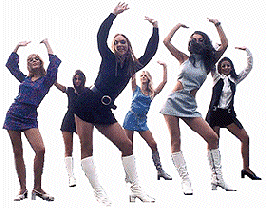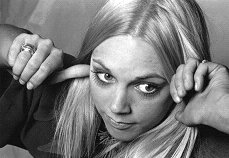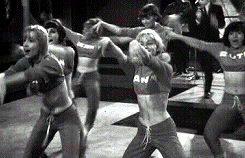Sixties
City presents
a wide-ranging series of
articles on all aspects of the Sixties, penned by the creator of the iconic
60s music paper Mersey
Beat
|
Sixties
City presents
a wide-ranging series of
articles on all aspects of the Sixties, penned by the creator of the iconic
60s music paper Mersey
Beat
|
|||||
|

|
The
popular ‘Top Of The Pops’ dance troupe, Pan’s People, began appearing
regularly on the series from May 1968. Producer Johnny Stewart had decided
to use dancers when an artist wasn’t able to attend and perform as this
was in the days prior to the development of the pop video, and the girls
were introduced into the series, which was then recorded in Manchester,
following its launch in 1964.
There had previously been another dance troupe on the weekly series called the Go Jo’s. Initially the Go Jo’s comprised three female dancers and was then enlarged to six. The Go Jo’s had been formed by Jo Cook, a member of the Beat Girls, who were featured in the weekly BBC2 show ‘The Beat Room’. The initial dancers had been Jo, Linda Hotchkin and Jane Bartlett. Jo then began to concentrate on choreography and managing the group and Thelma Bignell and Barbara van der Heyde were recruited. By 1968 they had become a six-piece with the inclusion of Lesley Larbey and Wendy Hillhouse. They made their final appearance on ‘Top of the Pops’ in June 1968 dancing to ‘Jumpin Jack Flash’ by the Rolling Stones. The five girls in Pan’s People had appeared on previous TV shows and in a TV series in Amsterdam, but it was on ‘Top Of The Pops’ that they became tremendously successful. The original personnel were Felicity 'Flick' Colby, Ruth Pearson, Babs Lord, Dee Dee Wilde, Louise Clarke and Andrea 'Andi' Rutherford. Babs, Ruth and Dee Dee had been members of the Beat Girls. There was an internal disagreement within the outfit and three of them walked out, with Ruth approaching Flick Colby for an audition for the forthcoming troupe of Pan’s People. |
 |
|
Flick, an American who had trained as a ballet dancer, was the leader
and choreographer of the group and eventually ceased performing in the
troupe in 1971 to concentrate on choreography. Andy left to have a baby
late in 1972 and was replaced by Cherry Gillespie. Louise left in 1974
to begin a family and was replaced by Sue Menhenick. Babs was to marry
actor Robert Powell. The girls were attractive and sexy and had a huge
following. Flip was the choreographer of the programme for a considerable time but felt that after eight years, there needed to be a new troupe who included male dancers, so Ruby Flipper was formed, which also included Cherry and Sue. After six months the BBC decided to return to using an all-girl troupe and Legs & Co came into being, with Ruth and Flick as their managers. Legs & Co comprised Patti Hammond, Lulu Cartwright, Rosemary Hetherington, Gill Clark and Pauline Peters. That outfit left ‘Top of the Pops’ in 1981. The final dance troupe was a large outfit called Zoo, which comprised ten male and ten female dancers, who lasted on the programme until 1983. |
 
 |
| January
- March 1967 Flick Colby, Babs Lord, Dee Dee Wilde Penny Fergusson, Lorelly Harris, Felicity Balfour |
April
- December 1967 Flick Colby, Babs Lord, Dee Dee Wilde Penny Fergusson, Lorelly Harris, Ruth Pearson |
December
1967 - March 1968 Flick Colby, Babs Lord, Dee Dee Wilde Louise Clarke, Lorelly Harris, Ruth Pearson |
March
1968 - February 1972 Flick Colby, Babs Lord, Dee Dee Wilde, Louise Clarke Andi Rutherford, Ruth Pearson |
September
- October 1969 Flick Colby, Babs Lord, Dee Dee Wilde, Louise Clarke Andi Rutherford, Penny Fergusson |
February
- September 1972 Babs Lord, Dee Dee Wilde, Louise Clarke Andi Rutherford, Ruth Pearson |
| September
- December 1972 Babs Lord, Dee Dee Wilde, Louise Clarke Ruth Pearson |
December
1972 - May 1974 Babs Lord, Dee Dee Wilde, Louise Clarke Cherry Gillespie, Ruth Pearson |
May
1974 – September 1975 Babs Lord, Dee Dee Wilde, Sue Menhenick Cherry Gillespie, Ruth Pearson |
September
- October 1975 Dee Dee Wilde, Sue Menhenick, Cherry Gillespie Ruth Pearson, Mary Corpe, Lee Ward |
October
1975 - April 1976 Sue Menhenick, Cherry Gillespie, Ruth Pearson Mary Corpe, Lee Ward |
April
1976 Sue Menhenick, Cherry Gillespie, Ruth Pearson Mary Corpe |
|
Article
Text
UK
web hosting by
|